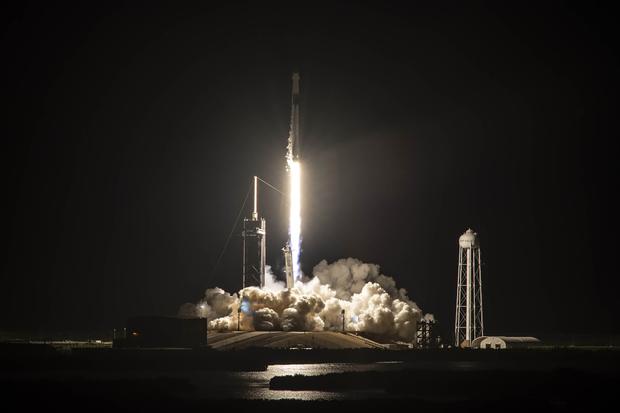SpaceX launched four private citizens to space on Wednesday, kicking off the first-ever crewed mission to orbit without any professional astronauts on board. Dubbed Inspiration4, the mission marks the latest private foray into space as companies like Elon Musk’s SpaceX compete to normalize space travel for paying tourists, not just government astronauts.
The five-hour launch window for Inspiration4 opened at 8:02 p.m. ET for launch from Launch Complex 39-A at the Kennedy Space Center.
The crew was buckled inside SpaceX’s Crew Dragon Resilience capsule at the top of the rocket, reusing the spacecraft that sent four government astronauts to the International Space Station nearly a year ago. It’s poised to spend roughly three days orbiting Earth at a higher altitude, some 360 miles above ground — the farthest human spaceflight since the last NASA space shuttle mission to repair the Hubble telescope in 2009.
/cdn.vox-cdn.com/uploads/chorus_asset/file/22854133/Sep_15_2021_20_37_13.gif)
Rather than just climbing to the edge of space and returning to land in less than an hour as Virgin Galactic and Blue Origin recently did, Inspiration4 will circle the Earth and do so in a higher orbit than the International Space Station.
Paying for it all is Jared Isaacman, a 38-year-old billionaire high-school dropout, who is promoting the flight as a massive fundraising effort for St. Jude Children’s Research Hospital.
Isaacman, a pilot who is qualified to fly commercial and military jets, reached a deal with SpaceX in late 2020 for the mission. Neither is saying how much he is paying SpaceX for the launch, though Isaacman has said it was far less than $200 million he hopes to raise for St. Jude.
“This dream began 10 months ago,” Isaacman said at a news conference Tuesday, noting how quickly the mission came together. “We set out from the start to deliver a very inspiring message, certainly the opportunities up in space and what can be done there. But also what we can accomplish here on Earth.”
SpaceX and Isaacman unveiled their project to the world in a TV ad that ran during the Super Bowl in February encouraging people to apply for the mission.
Roughly nine minutes after liftoff, Falcon 9’s first stage booster returned to Earth for a landing on a barge in the Atlantic Ocean. Minutes later, the Crew Dragon capsule separated from the rocket’s second stage as it was leaving Earth’s atmosphere, sending the Inspiration4 crew further toward orbit. The capsule will spend the next hour and a half gradually raising its orbit via intermittent thruster firings.

Netflix is also documenting the team’s preparation and flight for a series on its platform. While “Countdown: Inspiration4 Mission to Space” is labeled a documentary series, it is more akin to reality television than a Ken Burns film.
The crew has a few activities planned during their stay in orbit — Sembroski is expected to play a ukulele made by Martin Guitar that’s stowed onboard as one of the several sponsorships riding along for the mission. Proctor brought along poetry and some personal art. And the whole crew is participating in a study on the effects microgravity has on the human body. SpaceX, Translational Research Institute for Space Health (TRISH) at Baylor College of Medicine and investigators at Weill Cornell Medicine will collect biological samples from the passengers before the mission and plan to gather biomedical data on the passengers during the mission.
Exactly where and when the capsule reenters Earth’s atmosphere after its three-day mission depends on the weather conditions around the coasts of Florida. The capsule can spend up to a week in orbit if need be, Isaacman has said.






